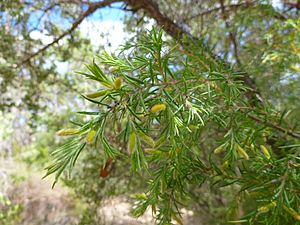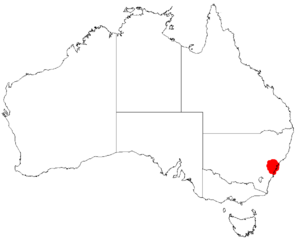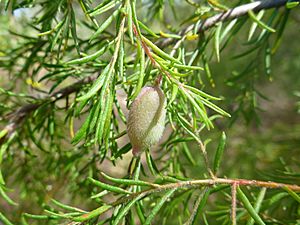Hairy geebung facts for kids
Quick facts for kids Hairy geebung |
|
|---|---|
 |
|
| In Yengo National Park | |
| Conservation status | |
| Scientific classification | |
| Genus: |
Persoonia
|
| Species: |
hirsuta
|
 |
|
| Occurrence data from Australasian Virtual Herbarium | |
| Synonyms | |
|
List
|
|
The Hairy Geebung (Persoonia hirsuta) is a special plant. It is also known as the hairy persoonia. This plant belongs to the Proteaceae family. It grows only in eastern New South Wales, Australia.
The Hairy Geebung is a shrub that can spread out or grow low to the ground. It has hairy branches, leaves, flowers, and fruit. Its leaves can be shaped like a spatula, an oval, or a narrow line. The flowers are yellow or orange. They grow alone or in groups of up to ten on a stem called a rachis. This stem can be up to 20 mm (0.79 in) long.
Contents
What the Hairy Geebung Looks Like
The Hairy Geebung is a shrub that spreads out or grows low. It usually reaches a height of 0.3–1.5 m (1 ft 0 in – 4 ft 11 in). Its small branches, leaves, flowers, and fruit are all covered in fine hairs.
The leaves are 5–14 mm (0.20–0.55 in) long and 0.7–5 mm (0.028–0.197 in) wide. Their edges often curve downwards or roll under. The flowers are yellow or orange. They are about 10 mm (0.39 in) long. They grow either by themselves or in groups of up to ten on a stalk. This stalk can grow up to 20 mm (0.79 in) long.
Most flowering happens from November to January. After the flowers, the plant produces a fleshy fruit. This fruit is called a drupe. It is green to cream-coloured and often has red streaks.
Naming the Hairy Geebung
The Hairy Geebung was first collected by John White in 1794. He found it near Port Jackson (Sydney). The plant was officially described in 1805 by Christiaan Hendrik Persoon. He gave it the scientific name Persoonia hirsuta.
In 1991, two scientists, Peter Weston and Lawrie Johnson, studied the plant more closely. They found that there are two slightly different types, called subspecies. Both are recognized by the Australian Plant Census.
- Persoonia hirsuta subsp. evoluta: This type has spatula-shaped or oval leaves. These leaves are 1.5–5 mm (0.059–0.197 in) wide. Their edges are usually turned down.
- Persoonia hirsuta subsp. hirsuta: This type has linear or narrow oblong leaves. These leaves are 0.75–1.5 mm (0.030–0.059 in) wide. Their edges are usually rolled under.
Where the Hairy Geebung Lives
The Hairy Geebung usually grows in open woodlands and heath areas. It prefers sandy soils.
The subspecies evoluta is found in certain spots. These include the Central Coast and Central Tablelands of New South Wales. You can find it in areas like Putty, Glen Davis, and Hill Top. It mostly grows at heights between 350 and 600 m (1,150 and 1,970 ft) above sea level.
The subspecies hirsuta grows closer to the coast. It is found from Gosford down to the Royal National Park. It usually grows within 20 km (12 mi) of the coast. Its altitude is typically lower than 300 m (980 ft).
Ecology and Life Cycle
Sometimes, the two subspecies of Hairy Geebung mix together. This happens in the lower Blue Mountains area. They can also create new types of plants by mixing with other Persoonia species. For example, subsp. evoluta can mix with P. mollis subsp. nectens.
The fruit of the Hairy Geebung is a food source for animals. Animals like kangaroos, possums, and large birds such as currawongs eat the fruit. This helps the plant spread its seeds.
Protecting the Hairy Geebung
The Hairy Geebung is an endangered species. This means it is at high risk of disappearing forever. It is protected by laws in Australia and New South Wales.
The plant lives in small groups that are spread out. These groups are threatened by several things:
- Urban development: New buildings and towns destroy its natural home.
- Clearing bushland: Land is cleared for other uses, removing the plants.
- Bushfires: Too many fires, or fires that happen too often, can harm the plants.
- Honeybees: European honeybees might not be good at pollinating Hairy Geebung flowers. This could mean fewer new plants are made.
Scientists and conservationists are working to protect this special plant.



